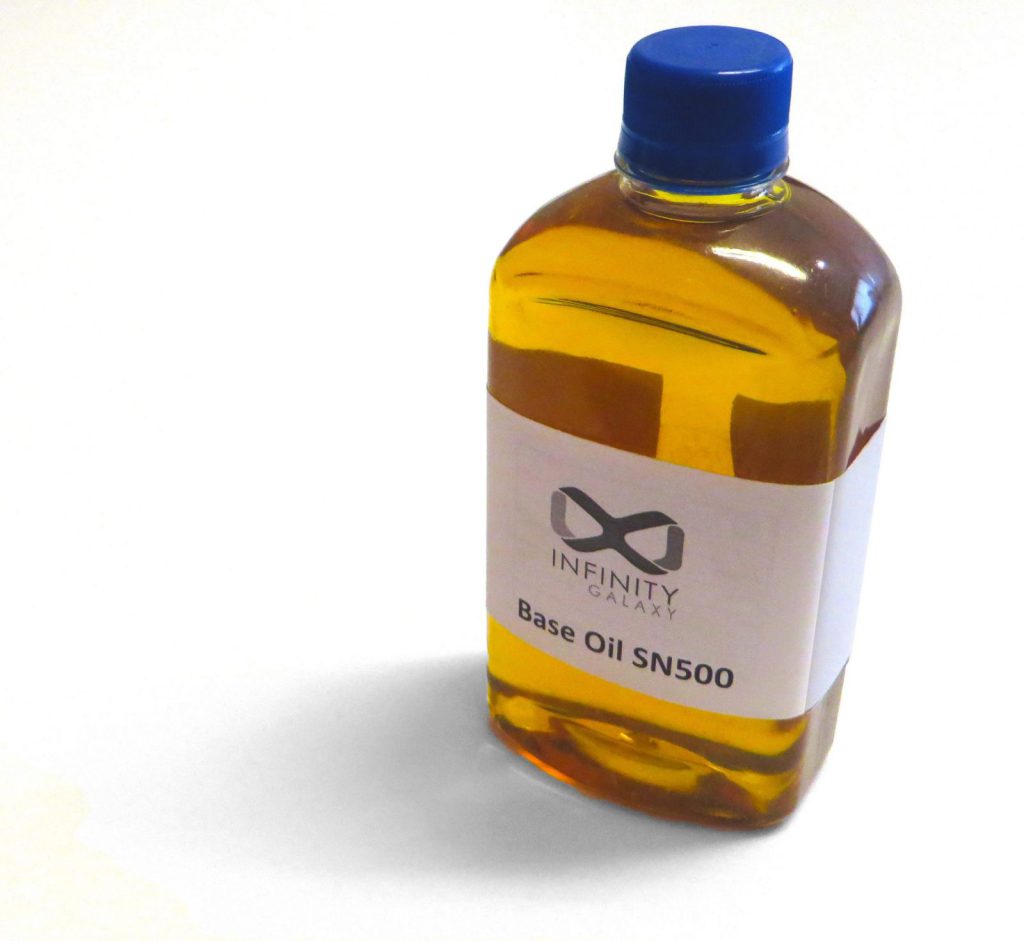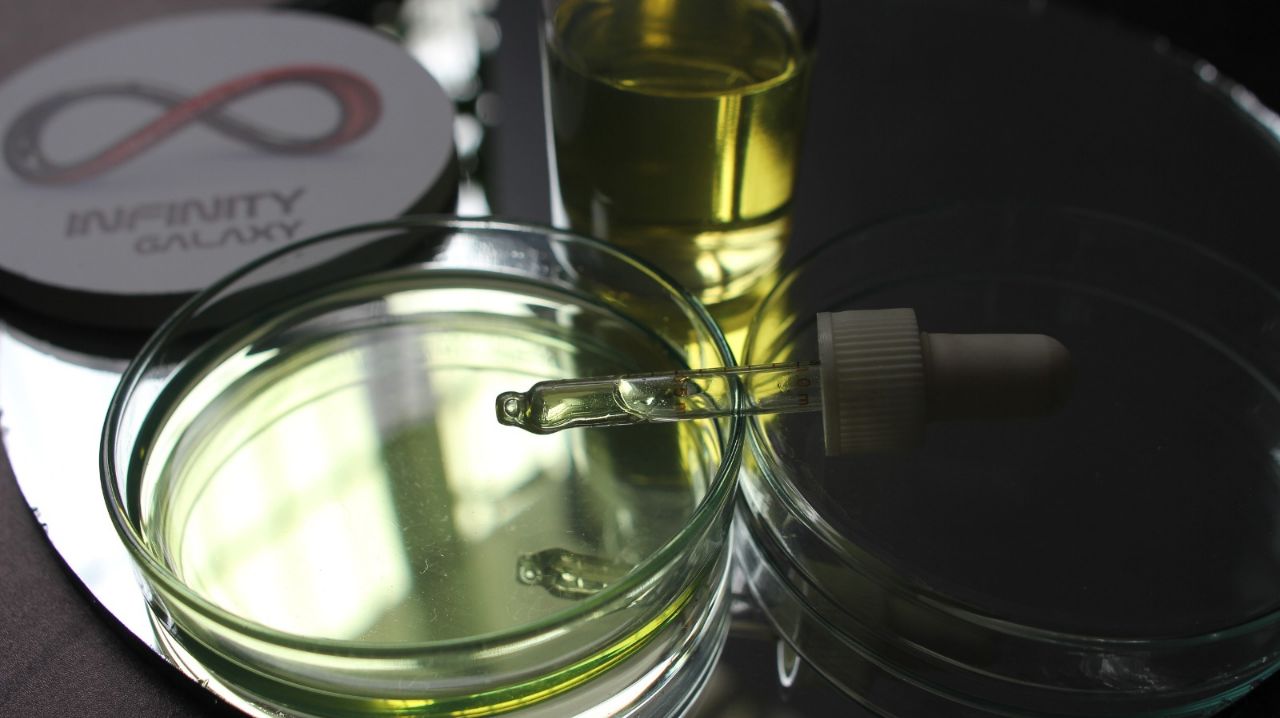Base oil types generally are as below :
- Mineral
- Synthetic
The mineral base oil can be obtained by means of refining crude oil.
A little portion of the crude oil, about 1 to 2% of a crude oil barrel is subjected to be refined to produce base oil. The rest is used to produce gasoline, diesel, kerosene, coke, bitumen and other hydrocarbons.
In the course of the heating process, light and heavy hydrocarbons separate. The light ones will be processed to produce petrol and other fuels, while the heavier ones are refined to produce bitumen and base oil.
The synthetic type is manufactured through chemical synthesis. This product is sorted into paraffinic base oil and naphthenic base oil based on the chemical structure of the molecules. It has hydrocarbons with 18 to 40 carbon atoms.
Naphthenic types have better solubility and qualifications at low temperatures compared to the other base oil types. Lubricating oil has about 1% to 20% of specific additives mixed with base oil.

The pure sample is obtained by the hydrogenation process in which sulfur and aromatics will be removed by applying hydrogen under high pressure.
The point of adding chemical additives to the base oil is to improve its quality for the products in terms of friction. For instance, certain types of motor oils contain more than 20 additives.
Base oil has been categorized into five main groups in terms of viscosity, the proportion of saturates and sulfur content, and other factors as below.
Base oil has been categorized into five main groups in terms of viscosity, the proportion of saturates and sulfur content, and other factors as below.
Group 1
API (American Petroleum Institute) has named this group as base stocks which contain less than 90% saturates and greater than 0.03 % sulfur with a viscosity index greater than or equal to 80 and less than 120.
Group 2
API ( American Petroleum Institute ) has named this group as base stocks which contain more than or equal to 90% saturates and less than or equal to 0.03 % sulfur with a viscosity index greater than or equal to 80 and less than 120.
Group 3
API (American Petroleum Institute) has named this group as base stocks which contain more than or equal to 90% saturates and less than or equal to 0.03 % sulfur with a viscosity index greater than or equal to 120. Group 3 is also known as synthetic technology oils or hydrocracked synthetic oils.
Group 4
The viscosity index of this group ranges from 125 to 200.
Group 4 consists of synthetic oils which are made of Poly Alpha Olefins (PAO). PAO Oils are much more stable in various temperatures compared to others.
PAO oils are highly recommended for being used in freezing areas as in Northern Europe as well as hot areas as in the Middle East.
Group 5
Group 5 is devoted to naphthenic oils and esters.
Base oil Grades & Specifications
Base oil exists in the market in different grades as follow
- SN 150
- SN 300
- SN 500
- SN 650
SN stands for Solvent Neutral base oil and the following numbers are based on the SUS Viscosity at 40 c. SN 150, SN 300 and SN 500 are light in color but the rest is dark. As a general notion, the more viscosity index is, the darker the color will be.
Infinity Galaxy dedicates the below specifications for different types of Base Oil:
- Base Oil SN 150
| Specifications of Infinity Galaxy Base Oil SN 150 | ||
|---|---|---|
| Test Items | Test Method | Test Results |
| Appearance | Visual | Bright & Clear |
| Color | ASTM D 1500 | 2.0 – 2.2 |
| Density @ 30 °C | ASTM D 1298 | 0.870 |
| Kinematic Viscosity @ 40 °C | ASTM D 445 | 30.0 – 31.54 |
| Kinematic Viscosity @ 100 °C | ASTM D 445 | 5.0 – 5.5 |
| Viscosity Index | ASTM D 2270 | 90 – 92 |
| Flash Point, °C | ASTM D 92 | 200 – 210 |
| Pour Point, °C | ASTM D 97 | -3 |
- Base Oil SN 300
Base oil SN 300 is a light grade oil with long shelf life and high thermal stability.
| Specifications of Infinity Galaxy Base Oil SN 300 | ||
|---|---|---|
| Test Items | Test Method | Test Results |
| Appearance | Visual | Bright & Clear |
| Color | ASTM D 1500 | 2.0 – 2.2 |
| Density @ 30 °C | ASTM D 1298 | 0.870 – 0.880 |
| Kinematic Viscosity @ 40 °C | ASTM D 445 | 45.0 – 65.0 |
| Kinematic Viscosity @ 100 °C | ASTM D 445 | 6.5 – 8.0 |
| Viscosity Index | ASTM D 2270 | 89 – 92 |
| Flash Point, °C | ASTM D 92 | 210 – 220 |
| Pour Point, °C | ASTM D 97 | -3 |
Base Oil SN 500
Base oil SN 500 is the most demanded grade among others. SN 500 is defined as a light grade base oil. It is highly used in lubricant productions.
Usage: Engine oils, gear oils, greases, hydraulic oils, transformer oils
| Specifications of Infinity Galaxy Base Oil SN 500 | ||
|---|---|---|
| Test Items | Test Method | Test Results |
| Appearance | Visual | Bright & Clear |
| Color | ASTM D 1500 | 2.0 – 2.2 |
| Density @ 30 °C | ASTM D 1298 | 0.885 – 0.890 |
| Kinematic Viscosity @ 40 °C | ASTM D 445 | 97.5 – 102.0 |
| Kinematic Viscosity @ 100 °C | ASTM D 445 | 10.5 – 11.5 |
| Viscosity Index | ASTM D 2270 | 89.0 – 92.0 |
| Flash Point, °C | ASTM D 92 | 225 – 235 |
| Pour Point, °C | ASTM D 97 | -3 |
Check Out Our Article about Recycled Base Oil







